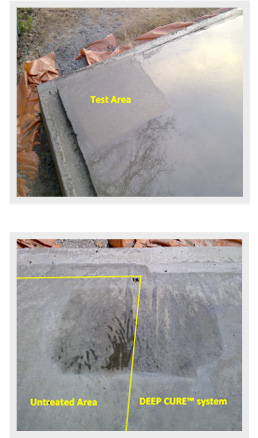

DEEP CURE is a non-membrane forming concrete curing compound that works in the concrete slab and not on the concrete surface.
Water based, ready to apply translucent liquid.
Why cure concrete?
The purpose of controlling the curing of concrete is to prevent the loss of moisture (water) during the time the concrete is gaining strength. The following are the benefits of curing concrete:
- Concrete not cured only achieves 40% of the strength compared to a cured concrete (after 6 months)
- Helps reduce the porosity of concrete, thereby increasing the durability and helping to prevent concrete cancer
- Prevents surface cracking due to early age shrinkage.
Curing Methods:
There are 4 main methods of curing concrete on site:
- Plastic sheeting – however it must be carefully and correctly placed to work well, must not be allowed to be blown up in the wind. A floor with plastic on it can be slippery causing OH&S issues during construction.
- Membrane forming curing compounds – are sprayed on to the concrete surface forming an impermeable skin. These compounds must comply with AS3799. However, these compounds must be ground off before the application off floor finishes such as vinyls, direct stick carpet, epoxy or polyurethane coatings, toppings and ceramic tile adhesives. Failure to do this will void manufactures warranties.
- Ponding – where a dam wall is placed around the edge of the slab and the pond is filled with water, which has to be continually refilled.
- Penetrating or internal curing – these compounds do not form a membrane (therefore they do not have to comply with AS3799) but penetrate the concrete surface, react with the cement powder and turn to a gel, blocking the movement of moisture out of the slab. They also harden / densify the slab, and help prevent efflorescence. They do not slow down the construction program as with other types of curing.

DEEP CURE ‘ticks’ all the boxes for being a fast, cost effective solution when curing concrete.
How DEEP CURE works:
To the right is a sweat test done using DEEP CURE, to check the migration of water out of the concrete. Thursday – photo shows an area not sprayed, and the rest of the area sprayed with the DEEP CURE™ system. It was sprayed 5.00pm after pouring the concrete slab in the morning.
Friday (morning) – the darker area of the photo was covered with plastic, and left there over the weekend.
Monday – this photo shows where the plastic was removed and the very dark (black) area is liquid water sitting on the surface. Water has sweated out of the untreated portion of the slab. The treated area has retained the water in the slab because the DEEP CURE™ has worked as a cure method.

Typical use areas:
- Concrete footings and pavements
- Precast concrete elements
- Balconies, roads and runways
- Buildings, bridges and infrastructure
Key Features:
- Safe and easy and fast application
- Can be walked on within 15-30 minutes
- Cannot be damaged during the construction process
- Does not leave a membrane that must be ground off prior to applying coatings, adhesives and toppings as required in the Flooring Code.
- Assists in the prevention of efflorescence and concrete cancer
- Enviro-friendly, odourless, non-toxic and waterbased
- Assists in the adhesion of coatings and adhesives
- Improves chemical resistance
- Prevents moss and mildew growth
Technical Information:
- Vehicle Type: Water based
- Viscosity: 2.4
- Specific Gravity: 1.1
- Drying time: 30 minutes @ 25ºC
- Finish: No change to substrate
- Colour: Translucent – dries clear
- Theoretical Coverage: 4.5 – 5m²/litre
- Freezing point: -20C
- Boiling Point: 1000C
- Abrasion Resistance: Excellent
- Bacterial Resistance: Excellent
- Chemical Resistance: Excellent
- Heat Resistance: Up to 1200C (dry heat)
- Solvent Resistance: Good
- Salt Spray Resistance: Good
- Thinning and cleaning: Water
- Durability: Excellent
- VOC Content: None
- Surface Bond: Excellent
Key Features:
- Equipment: Non Atomizing Spray e.g. Use knapsack or backpack.
- Cleaning: Water.
- Typical Specification: One coat, however if applied over a concrete block wall or pressed pavers, 2 applications may be required due to the porosity.

